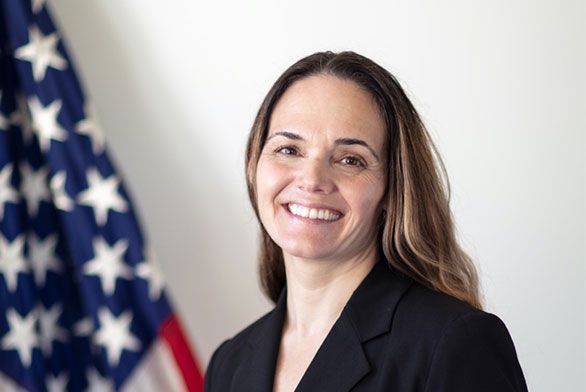Rachel Dudik (A02) Helps Set the Standard at the United States Naval Observatory
November 3, 2023 | By Jennifer Levin
When Rachel Dudik (A02) needed a job after graduating from St. John’s College, she jumped at the opportunity to spend the summer researching black holes at George Mason University, fascinated by beautiful photos of the night sky. Dudik had considered graduate school for visual art or forestry, but she also liked math and science and enjoyed her work at GMU far more than anticipated. So she ended up accepting a position at the school as a graduate research assistant and, over the following six years, completed her doctorate in astrophysics. Dudik credits St. John’s with giving her the confidence to tackle unfamiliar intellectual challenges—which, for her, has led to a rewarding career at the United States Naval Observatory (USNO), which sets the time standard for agencies across the globe.

Dudik joined the scientific and military facility in Washington, D.C. in 2008, where she steadily moved up the ranks of management. As the head of requirements and assessments, Dudik is responsible for ensuring that the USNO’s scientific programs meet necessary protocols and that their data products are accurate. She has also held roles as the USNO’s acting scientific director as well as its risk management framework program manager; network migration program manager; acting head of development, security and operations; and acting chief technology officer. In 2016, she received the Navy Meritorious Civilian Service Award for her work at the agency.
Dudik describes her current position at USNO as “kind of the liberal arts of the science world,” she says. “I’m not an expert at anything, but I know a little bit about everything. My strength is that I can use those experiences across multiple disciplines to come up with creative ideas, and use lessons learned from other places to help the development of new programs.”
Dudik has kept her research focus equally broad; instead of specializing in just one area of black holes, such as black holes in the visible band, she says she would “do a paper on this type of black hole on the visible band, and then a research paper on this kind of star—spreading out my palate of topics, which allowed me to ask more creative questions and make different associations than others might.”
Studying black holes might sound like the purview of NASA, but it also relates to the mission of the USNO, which was founded in 1830 as the Naval Depot of Charts and Instruments. Initially, it cared for the Navy’s chronometers, charts, logs, and other navigational instruments, and produced star almanacs used by ships for navigation. The USNO is still mandated by Congress to deliver those almanacs every year, and it also provides a software program that helps ships calculate and navigate using stars in situations where they might not have GPS. The agency’s modern mission, as stated on its official website, is to “define and apply the physical environment, from the bottom of the ocean to the stars, to ensure that the U.S. Navy has the freedom of action to deter aggression, maintain freedom of the seas and win wars.”
In simple terms, Dudik says, she and her colleagues continuously define time based on the location of the sun—so that, for instance, world markets have a standard reference, GPS systems can locate cars and space satellites, and airplanes don’t crash into each other. Dudik herself worked on the black hole science associated with the International Celestial Reference Frame, which sets the grid for the universe.
“Every day, we update what time is. Sometimes the Earth is speeding up, sometimes it’s slowing down. The Earth is rotating around the sun and on its axis, it’s wobbling on that rotation, and the orbit itself is changing based on the mass of the sun, and where the moon is, and the tides,” she says. “On top of that, the entire solar system is rotating around a black hole in the center of our galaxy.”
Achieving moment-to-moment accuracy in a relative system like time requires a tremendous amount of math as well as precision instrumentation. And more philosophical Johnnie-esque questions about the nature of time can tread into the theoretical. “I’m not an expert in that,” Dudik says, “but I don’t think there’s a good answer for what ‘Time’ with a capital ‘T’ is. Humanity has recognized the need to have a standard.”
Merging hard science with the awe she first experienced looking at photos of the night sky, Dudik says to imagine yourself alone in a field, staring up at the stars and wondering where you are in relation to them. “The stars you can see are rotating around the galaxy,” Dudik explains. “When you turn around in a circle, you need a reference point to know that you’ve turned around in a circle. If you don’t have a reference point, you don’t know what a full rotation is. Every day, we’re answering that question, pinning it down, redefining what time is.”
Dudik lives with her husband and their two young sons in Arlington, Virginia, near the Potomac River, where she takes advantage of trails for hiking and running and strives for a satisfying work-life balance. She dreams of one day getting back to pure research, which indulges her penchant for creative thinking.
“True research is much more artistic than you think,” she says. “It’s extremely difficult for people to come up with an idea to start to explore a question. It’s not just a question for the sake of a question, but a question that gets back to a fundamental understanding of our universe. St. John’s students are comfortable with this kind of thinking.”

